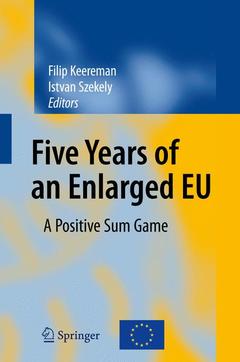Description
Five Years of an Enlarged EU, 2010
A Positive Sum Game
Coordinators: Keereman Filip, Szekely Istvan
Language: French
Subjects for Five Years of an Enlarged EU:
Five Years of an Enlarged EU
Publication date: 10-2014
256 p. · 15.5x23.5 cm · Paperback
Publication date: 10-2014
256 p. · 15.5x23.5 cm · Paperback
Five years of an enlarged EU: A positive sum game
Publication date: 08-2010
256 p. · 15.5x23.5 cm · Hardback
Publication date: 08-2010
256 p. · 15.5x23.5 cm · Hardback
Description
/li>Contents
/li>Comment
/li>
The Fifth Enlargement that took place in 2004 and 2007 was a milestone in the history of the European Union. Not only because of the large number of acceding countries but also because of their recent political and economic experience. Ten of them had undergone a profound transition from a totalitarian regime to democracy, and from a centrally planned economy to a market-based system. Most of them had income levels signi?cantly below those of the then EU-15. Now, 6 years later, we can clearly see that the process of European integration, both before and after 2004, was what enabled Europe to overcome the gaps between various parts of the continent. The enlargement made Europe a better and wealthier place and streng- ened its position in the world. Integration into the European Union has always been one of the strongest incentives for reform in the new Member States. Particularly important in my view have been the development of ?nancial markets through foreign direct investment and capital in?ows, and the opening of labour markets ? which was a two-way phenomenon, with markets being opened up in acceding as well as the incumbent Member States. The Fifth Enlargement was thus an exercise of glo- lisation in miniature, a practice run for the Union to tackle the challenges of the ever smaller world.
Overview.- Overview.- Trade and Foreign Direct Investment in an Enlarged EU: Opportunities and Challenges.- Evolving Pattern of Intra-industry Trade Specialization of the New Member States of the EU: The Case of the Automotive Industry.- FDI Spillovers in the Czech Republic: Takeovers Versus Greenfields.- Comments on Chapter 2 and 3.- Migration in an enlarged EU: solution or problem for labour market woes and cash-strapped social security systems?.- Migration in an Enlarged EU: A Challenging Solution?.- The Consistency of EU Foreign Policies Towards New Member States.- Comments on Chapters 5 and 6.- Financial integration and stability in an enlarged EU.- Real Convergence, Financial Markets, and the Current Account: Emerging Europe Versus Emerging Asia.- Sustainable Real Exchange Rates in the New EU Member States: Is FDI a Mixed Blessing?.- Comments on Chapters 8 and 9.- Integration, Openness and Growth: Did Accession Make a Difference?.- The Second Transition: Eastern Europe in Perspective.- An Evaluation of the EU’s Fifth Enlargement with Special Focus on Bulgaria and Romania.- Comments on Chapters 11 and 12.
Numerous charts and tables
Insights into the driving forces of integration and growth after the 2004 EU enlargement
With contributions by international experts
Includes supplementary material: sn.pub/extras
© 2024 LAVOISIER S.A.S.
These books may interest you

Democracy and Judicial Reforms in South-East EuropeBetween the EU and the Legacies of the Past 52.74 €

Democracy and Judicial Reforms in South-East EuropeBetween the EU and the Legacies of the Past 52.74 €

Europe — Toward the Next Enlargement 105.49 €

